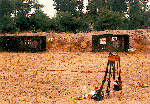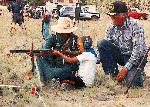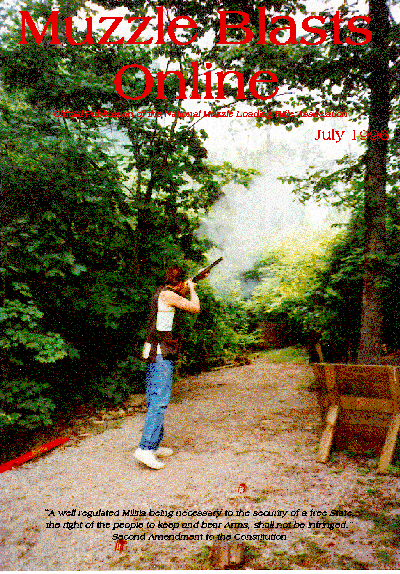|
Muzzle Blasts Online |
|
...for the muzzleloading enthusiast |
|
The muzzleblasts.com domain, subdomains, content, etc., are neither affiliated with the NMLRA nor its paper magazine Muzzle Blasts |
|
Muzzle Blasts Online |

|
|
|
|
|
|
Primitive Aggregates for Young Shooters
It's incredibly important for young children to have a positive first experience in shooting black powder guns. Our future as a sport depends on it. Most people think of them as modified adults, but in reality all adults are just modified children.
I've been shooting muzzleloaders for about five years now, but didn't become a fanatic until I got a flintlock about a year ago. In the interim, my children grew up to become young teenagers, and I've learned a lot about how children really have fun at a shooting range.
For one thing, children under 10 or 12 years old don't really care about the difference between a 20 and a 45x on a paper target. They also don't remember, three days later when the awards ceremony comes around, how they shot last Thursday. For children under 10, even a three target match is longer than they can hang in there. (Don't misunderstand me, however; they are competitive, just not long in concentration!)
So here are some pointers on setting up some great fun for small kids at shoots and rendezvous. These events are for children 5 to 12 years old and are geared for the new shooters. The size of the rifles you use in your clinics is important. I recommend 45 caliber or smaller, because you can lighten up the powder loads and still hit things at close range. You need at least two small rifles, one with a trigger pull of 10 to 11 inches and one slightly larger. I have a Thompson Center Cherokee that works quite well with bigger kids. Here's the important thing: 10 to 20 grains of powder, maximum. You have to adjust powder by body weight, not what the rifle shoots the best and keep in mind the targets are going to be close to the shooter. If the gun kicks a youngster once, he or she won't be back for awhile. Some 10 to 12 year olds have their own rifles, can load with supervision, and already shoot well. By all means assign an adult to watch them load and make sure they have the muzzle in a safe direction, and then let them strut their stuff.
 When you get serious about doing this you need to plan ahead and get a separate
range for the little ones. Post the majority of your targets at 10 to 15 paces. The best
targets are big, close, make noise, explode, or can be taken home. Balloons with a
little water in them (so the don't blow in the wind) and stapled to a backer or hung from
a string make a nice splash and pop. Also try playing cards stapled close together. If
you can hit the backstop, you'll get a card as a keepsake. How many "big boys" have
cut cards in their hat bands? I suggest a Pinochle deck with lots of royalty.
When you get serious about doing this you need to plan ahead and get a separate
range for the little ones. Post the majority of your targets at 10 to 15 paces. The best
targets are big, close, make noise, explode, or can be taken home. Balloons with a
little water in them (so the don't blow in the wind) and stapled to a backer or hung from
a string make a nice splash and pop. Also try playing cards stapled close together. If
you can hit the backstop, you'll get a card as a keepsake. How many "big boys" have
cut cards in their hat bands? I suggest a Pinochle deck with lots of royalty.
Clay pigeons are also a good choice. Use push pins to hang them on a chunk of wood. Gongs are very satisfying, but be careful; a light powder load will cause the bullet to ricochet back at you. If you decide to use gongs, place them out at about 20 yards away and angle them so that the bullet is deflected to the side. Use at least two sizes of targets, bigger ones for a try and smaller ones for a challenge. If you run a competition, feel free to let each child shoot at the gong that best meets his or her chances for success. The older kids want the challenge, and the younger kids need the confidence.
The reason you need your own range space is that children need immediate feedback, they can't wait for the end of a half-hour relay. They are thrilled to get to pull the trigger, but really want to go up and check what happened right after the shot, not to mention collect what's left of anything they hit. I'm too busy watching trigger fingers and partially supporting the rifle, to watch where the shot goes.
When you get ready for the kids, you will need three distinct zones: where they sit, where you load, and where they shoot (the firing line). I start the clinic with a short talk, usually five minutes or less, about the rifles. They need to know how a rifle works, and I start with a flintlock (and a flash in the pan) and then show them a caplock. They get a few terms, a bit about how to load, what the sights look like, and some of the great old expressions like "lock, stock and barrel".
Safety is a must, of course. I have two sets of earmuffs and safety glasses for each rifle-one for the kid who's shooting, and one for the one who's next. Explain the basic range rules, like those regarding where to keep the muzzle pointed, where to cap or prime, and what "range closed" means.
Each child has to remain seated until it is his or her turn. Then the child comes up to watch me load, and usually they have lots of questions. I often find a helper to load; my son and my husband both get drafted on a regular basis. I carry the rifle to the line and position the child to shoot. As the older children get more confident, let them carry the rifle to the line.
I start each child shooting with the dominant hand, but if the child leans over the rifle to use the other eye, I have them shoot the other way on their next turn. Closing one eye helps most of them. Always have them place their trigger finger along the stock of the gun until you have them set up to shoot. I have used both a small adjustable bench and cross-sticks, but a lot of time is spent messing with the sticks. If you have a small bench, remember to have a shoulder pad like a dish towel or cloth on hand to protect those little collar bones.
 I have also had success with holding the rifle while the child is seated or kneeling, and I
support the forestock with my hand rested on my leg. You'll have to mention sights
each time: "Find the front sight, fit it in the groove, and then find the target." The
littlest ones almost always shoot high because they can only find the front sight.
Suggest to the child that he or she lay a cheek along the stock of the rifle. Older
children will do this naturally while trying to line up the sights. Very young kids may not
get it, so another adult holding the rifle, adjusting for height, and aiming in the general
direction can be a great help. Remember that they will have fun just getting to pull the
trigger and making the boom happen; don't frustrate them with too many instructions.
I have also had success with holding the rifle while the child is seated or kneeling, and I
support the forestock with my hand rested on my leg. You'll have to mention sights
each time: "Find the front sight, fit it in the groove, and then find the target." The
littlest ones almost always shoot high because they can only find the front sight.
Suggest to the child that he or she lay a cheek along the stock of the rifle. Older
children will do this naturally while trying to line up the sights. Very young kids may not
get it, so another adult holding the rifle, adjusting for height, and aiming in the general
direction can be a great help. Remember that they will have fun just getting to pull the
trigger and making the boom happen; don't frustrate them with too many instructions.
Keep things moving. As they get more experience, give them more information. Make sure everybody hits something. Don't worry if they start with their eyes closed; by the third shot they'll be looking down the barrel. Some children are scared, because they think it's going to hurt. Make sure it doesn't.
Run everybody through several shots and let them choose a target. They will want to take home a piece of the clay birds, and any cards that they hit. At the Colorado State Shoot I run an aggregate after our practice rounds. The aggregate consists of three or four shots and a knife and hawk throw. For the card competition, I move the cards about two inches apart, and have them call it, or I post cards face down and use the higher card for a tie breaker.
Now most of the kids have been driving the hawk range officer crazy for at least two days by the time my competition comes around, and many of the kids have their own equipment. For the littlest ones, let them throw a hawk twice instead of a knife. If you need a tie breaker, let them throw it off. Don't get too concerned about placement, everybody wins something.
 After the aggregate, we have a blanket pick. The kids usually are electric by this time
(and usually I'm exhausted). My blanket is supported by contributions of less than $5
by traders and from shooters going through their plunder boxes for extra items that they
have won but probably will never use. Inexpensive pocket knives and flint and steel
are always coveted prizes, but I always require parental permission for choosing those
items. Make sure you have enough prizes that everyone goes away with something
that they like.
After the aggregate, we have a blanket pick. The kids usually are electric by this time
(and usually I'm exhausted). My blanket is supported by contributions of less than $5
by traders and from shooters going through their plunder boxes for extra items that they
have won but probably will never use. Inexpensive pocket knives and flint and steel
are always coveted prizes, but I always require parental permission for choosing those
items. Make sure you have enough prizes that everyone goes away with something
that they like.
At the big awards ceremony at the end of the shoot, it's nice to give each child a medallion and have them all come forward for recognition as a group. You don't need to tell scores or positions; they all competed and are all winners in my book.
My prize box goes with me now to smaller events. At teaching rendezvous the kids just shoot, as in my clinic. Smaller blanket shoots are lots of fun at other events. Parents that come along can always be recruited as score keepers and for crowd control. These events work the best if you have no more than eight children at a time. Use a sign up sheet at the beginning of the event or split the children into groups and have some of them come back in an hour.
I've noticed that the kids are better behaved at a shooting clinic than any other place. They really want a chance to shoot a rifle. The only warning I've ever needed to make is one comment about not having enough time to watch their behavior and load a rifle; this usually makes it an easy choice for them. I get continual feedback from clinics that the kids would like more shooting time.
I've never won a greater prize in muzzleloading than the smiles I get at the end of one of these events. If you choose to try a muzzleloading clinic for kids, be prepared to keep shooting regardless of rain or howling wind, and get ready to wait out thunderstorms. The kids won't want to leave, and for many of them it may be their only chance that year to shoot a muzzleloader (what a bummer). It's well worth the effort to make these events happen, especially when you walk through the camp and every kid knows your name. Imagine the wonderful stories they will have to tell back at school, or around the fire.
Remember: small rifles, small loads, immediate feedback, and prizes. Don't make them wait too long. Be safe, but not serious. The kids will love you for it.
